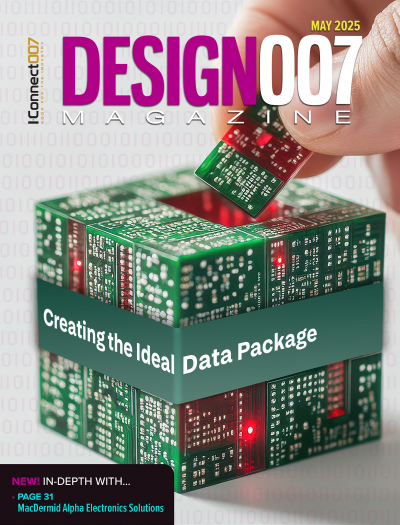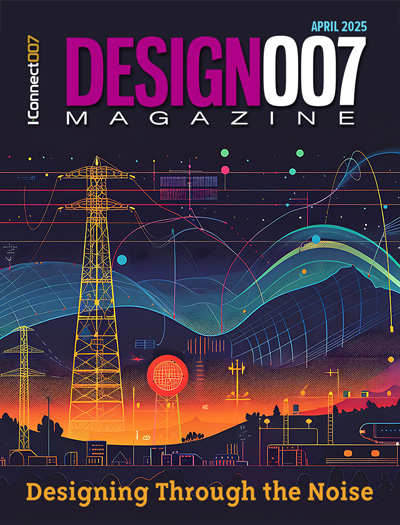-

- News
- Books
Featured Books
- design007 Magazine
Latest Issues
Current Issue
All About That Route
Most designers favor manual routing, but today's interactive autorouters may be changing designers' minds by allowing users more direct control. In this issue, our expert contributors discuss a variety of manual and autorouting strategies.

Creating the Ideal Data Package
Why is it so difficult to create the ideal data package? Many of these simple errors can be alleviated by paying attention to detail—and knowing what issues to look out for. So, this month, our experts weigh in on the best practices for creating the ideal design data package for your design.

Designing Through the Noise
Our experts discuss the constantly evolving world of RF design, including the many tradeoffs, material considerations, and design tips and techniques that designers and design engineers need to know to succeed in this high-frequency realm.
- Articles
- Columns
- Links
- Media kit
||| MENU - design007 Magazine
True DFM: Taking Control of Your EDA Tool
February 1, 2017 | Kelly Dack, CID+Estimated reading time: 3 minutes
We PCB designers are doing some truly great things with our layout tools. But we must remember that these tools are so powerful that they will sometimes allow us to design things that can’t be manufactured! We must collaborate with our fabricator and assembly brethren and embrace the best DFM practices, or face the consequences downstream.
Something as seemingly simple as copper-to-edge spacing provides us with plenty of examples of DFM techniques, potentially good and bad.
Providing a sufficient amount of copper-to-edge spacing allows for the least costly manufacturing processes at the PCB fabrication and assembly levels. Extremely tight manufacturing etching and routing tolerances enable the close registration of copper to the cut board edge. On very tight layouts, we see a router profile that is intended to come within .007” of a copper trace. You may have seen closer—and even cases where the copper is designed to extend beyond the the board edge effectively wrapping around the board edge.
Granted, sometimes we designers intend for the copper to exist in close proximity to a board edge profile. When close copper-to-edge distance is intended, we ought to always be sure that the copper will end up protected with a coating of resin (if still laminated within the PCB) or plated with a surface finish in order to prevent oxidation or other forms of contamination.
While copper print and etch factors are more accurate than ever, and your PCB layout tool will allow you place that copper trace very close to that board edge, stop and wait a minute. Think about how this PCB will be fabricated and assembled.
If you don’t know, set up a meeting with your PCB fabricator and assembler. Ask your manufacturing representatives about their capabilities and processes. Take note, though, with regard to the context of this conversation. If you ask how close you can design copper to the board edge, you will (and should) get an entirely different response than if you were to ask how far away should you keep your copper from the board edge. Here’s why:
A PCB board fabricator is in the business of creating very fine images out of copper that will be matched with a drill pattern and registered very accuratly onto a board outline. If this is accomplished as a one-up PCB intended for manual assembly, there are few problems if the PCB is designed such that the copper-to-edge spacing comes within .010” (0.25 mm) or greater. But this scenario can plant the seed of failure if the board design is destined for automated assembly.
After a prototype PCB layout is blessed by the engineering team, the determination is made to get on with production. This is when the lightning bolt of manufacturing reality is set to strike. While the PCB fabricator has done his best to accurately route the board edge very close to the copper conductors as designed, this awsome capability has tied the hands of the assembly provider who may be under contract to build thousands of these PCBs. You see, a prototype fabricator’s working panel can cut very close to the copper when building one-ups that will be shipped as single PCBs. But a PCB going to volume production must be designed to be included into an assembly array. There will be extra features which the assembly provider’s engineers will be adding to allow for ease of de-paneling or excising the boards from the array. These features all require varying amounts of space relative to the PCB edge.
To read this entire article, which appeared in the January 2017 issue of The PCB Design Magazine, click here.
Suggested Items
The Evolution of Picosecond Laser Drilling
06/19/2025 | Marcy LaRont, PCB007 MagazineIs it hard to imagine a single laser pulse reduced not only from nanoseconds to picoseconds in its pulse duration, but even to femtoseconds? Well, buckle up because it seems we are there. In this interview, Dr. Stefan Rung, technical director of laser machines at Schmoll Maschinen GmbH, traces the technology trajectory of the laser drill from the CO2 laser to cutting-edge picosecond and hybrid laser drilling systems, highlighting the benefits and limitations of each method, and demonstrating how laser innovations are shaping the future of PCB fabrication.
Day 2: More Cutting-edge Insights at the EIPC Summer Conference
06/18/2025 | Pete Starkey, I-Connect007The European Institute for the PCB Community (EIPC) summer conference took place this year in Edinburgh, Scotland, June 3-4. This is the third of three articles on the conference. The other two cover Day 1’s sessions and the opening keynote speech. Below is a recap of the second day’s sessions.
Day 1: Cutting Edge Insights at the EIPC Summer Conference
06/17/2025 | Pete Starkey, I-Connect007The European Institute for the PCB Community (EIPC) Summer Conference took place this year in Edinburgh, Scotland, June 3-4. This is the second of three articles on the conference. The other two cover the keynote speeches and Day 2 of the technical conference. Below is a recap of the first day’s sessions.
Preventing Surface Prep Defects and Ensuring Reliability
06/10/2025 | Marcy LaRont, PCB007 MagazineIn printed circuit board (PCB) fabrication, surface preparation is a critical process that ensures strong adhesion, reliable plating, and long-term product performance. Without proper surface treatment, manufacturers may encounter defects such as delamination, poor solder mask adhesion, and plating failures. This article examines key surface preparation techniques, common defects resulting from improper processes, and real-world case studies that illustrate best practices.
RF PCB Design Tips and Tricks
05/08/2025 | Cherie Litson, EPTAC MIT CID/CID+There are many great books, videos, and information online about designing PCBs for RF circuits. A few of my favorite RF sources are Hans Rosenberg, Stephen Chavez, and Rick Hartley, but there are many more. These PCB design engineers have a very good perspective on what it takes to take an RF design from schematic concept to PCB layout.


